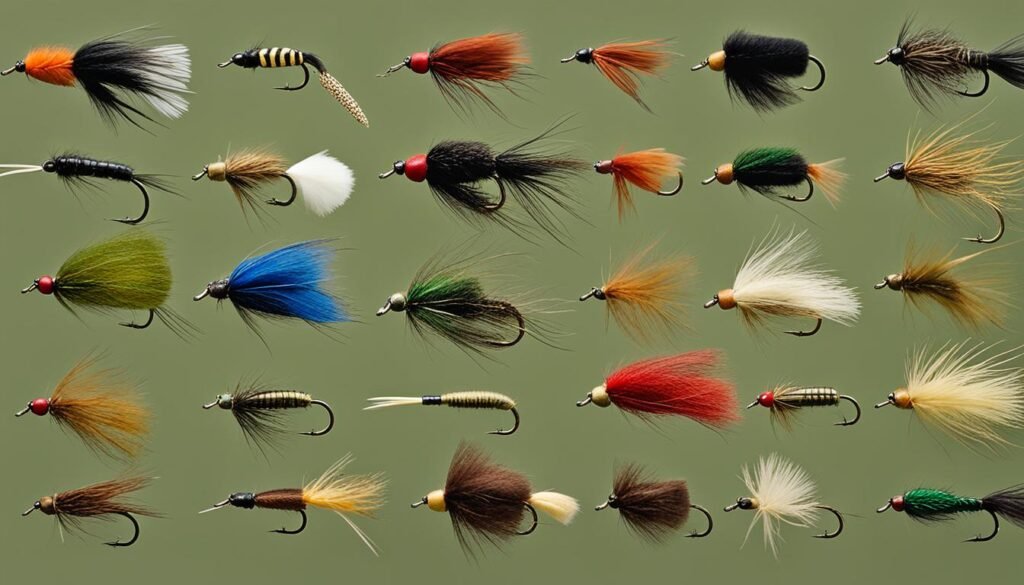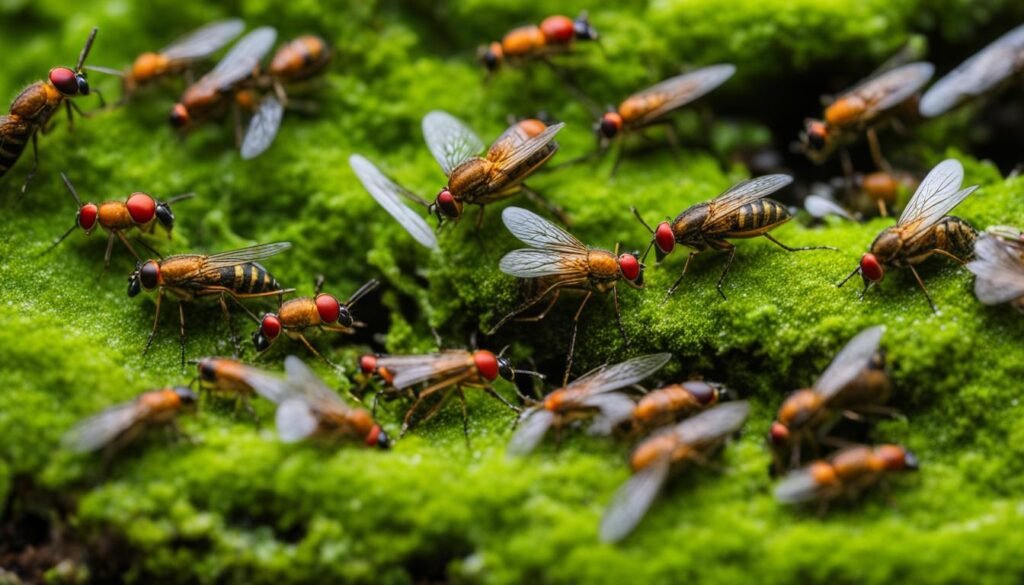Fishing terrestrials requires a combination of stealth and an understanding of trout behavior. By choosing the right fly size and pattern based on the conditions and the preferences of the fish, you can greatly increase your chances of a successful catch. In this article, we’ll explore the importance of terrestrials for trout diet and energy intake, recommend the best terrestrial flies for fly fishing success, discuss techniques for fishing with terrestrials, and provide tips for fishing terrestrials in different weather conditions. So, whether you’re a seasoned angler or new to fly fishing, this guide will equip you with the knowledge and skills to optimize your catch with terrestrial flies.
Importance of Terrestrials for Trout Diet and Energy Intake
Understanding the importance of terrestrials in a trout’s diet and energy intake is crucial for successful fly fishing. Studies have shown that adult trout are adept at evaluating the caloric value of prey and balancing their energy expenditures with energy inputs. Terrestrials, such as beetles and grasshoppers, offer higher calorie content and more substantial “meat” compared to aquatic insects like mayflies.
In small streams, where large insect-producing riffles may be lacking, terrestrials can make up a significant portion of a trout’s diet. These land-bred insects, including beetles and ants, often provide trout with a readily available and abundant food source. When fishing in small streams, attracter flies like Humpys and Royal Wulffs can be particularly effective in imitating terrestrials and attracting trout.
Terrestrials also prove to be more productive on windy days and from late morning through evening, as these are the times when terrestrial insects are most active and likely to fall into the water. Trout are naturally attuned to this behavior and will actively target these insects, making it an opportune time to present terrestrial imitations and optimize catch potential.
The significance of terrestrials as a food source for trout:
- Terrestrials provide higher caloric value compared to aquatic insects
- Small streams often lack large insect-producing riffles, making terrestrials a significant part of trout’s diet
- Attracter flies can effectively imitate land-bred insects and attract trout in small streams
- Terrestrials are more productive on windy days and from late morning through evening
Best Terrestrial Flies for Fly Fishing Success

When it comes to selecting the best terrestrial flies for fly fishing, it’s not necessary to have a broad selection. Fish are seldom selective to a specific kind of beetle or ant. The key is to carry a range of sizes to match the trout’s preferences on a given day or in a specific river. By selecting the right terrestrial fly, you can optimize your catch and increase your chances of fly fishing success.
Recommended Terrestrial Fly Patterns
- Schroeder’s Hi-Vis Hopper
- Quick Sight Beetle
- Travis Para-Ant
- Terrestrial Selection (popular patterns and sizes)
These recommended terrestrial fly patterns imitate beetles, ants, grasshoppers, and other land-bred insects that are highly effective in attracting trout. Remember, the size and pattern of the fly should be chosen based on the conditions and the preferences of the fish. Having these fly patterns in your tackle box will give you the flexibility to adapt to different fishing situations and increase your chances of a successful fly fishing outing.
Techniques for Fishing with Terrestrial Flies

Fishing with terrestrial flies requires a combination of stealth and precise casting technique to maximize your chances of success. Here are some tips to help you enhance your terrestrial fly fishing skills:
1. Be Stealthy:
Trout can be easily spooked, so it’s important to approach the water quietly and avoid making sudden movements. Stay low, move slowly, and minimize any disturbances that could alert the fish to your presence. This will increase your chances of getting closer to the fish without scaring them away.
2. Make Accurate Casts:
Terrestrial flies should be presented with precision to specific target areas where trout are likely to be feeding. Practice your casting technique to improve your accuracy and consistency. Aim for small pockets of water, behind rocks, under overhanging branches, and along the banks where terrestrials are likely to fall or become trapped. This will give you the best chance of enticing a strike.
3. Create a Distinct Plop:
When casting your terrestrial fly, try to create a distinct plop as it hits the water. This can mimic the sound of an insect falling into the water, attracting the attention of nearby trout. The noise can be created by allowing a little extra line to slip through your fingers during the cast. Experiment with different casting angles and strengths to find the right balance between creating a plop and avoiding spooking the fish.
4. Consider Using a Strike Indicator:
Using a strike indicator, such as a small float or a piece of brightly colored yarn, can be helpful when fishing with terrestrial flies. It allows you to track the movement of your fly and detect subtle strikes that may otherwise go unnoticed. Attach the indicator a few feet above your fly so that it remains visible but doesn’t interfere with the natural drift of the fly.
Fishing Terrestrials in Different Weather Conditions
When it comes to fishing terrestrials, understanding how weather conditions can impact your success is crucial. Different weather patterns can influence the activity levels of terrestrial insects, and knowing how to adapt your fly selection and presentation accordingly can significantly improve your chances of a successful fishing trip.
Fishing in Warm and Dry Weather
Warm and dry weather is ideal for terrestrial fishing. During these conditions, terrestrial insects become more active and venture closer to the water, making them easier targets for trout. Take advantage of this by using fly patterns that imitate beetles, ants, grasshoppers, and other land-bred insects. Pay close attention to areas with vegetation and brush, as trout often use these as feeding and hiding spots.
Fishing on Windy Days
Strong winds can displace terrestrial insects, causing them to fall into nearby streams and rivers. This makes windy days excellent for fishing terrestrials. The windier it gets, the more insects you can expect to see in the water. Use this opportunity to present your flies in riffles and runs, where ants and beetles are more likely to get swept away by the current.
Fishing after Rain Events
Sudden rain events can flush terrestrial insects into the water, creating feeding opportunities for trout. When it starts raining, be ready to switch to fly patterns that imitate drowned beetles, ants, and grasshoppers. Focus your efforts near streamside vegetation and areas where rainwater runoff is likely to bring in terrestrial insects.
Be Aggressive and Experiment with Terrestrial Fly Fishing
Fishing with terrestrial flies requires a bold and assertive approach. To maximize your chances of success, be willing to cast with confidence and precision, even in challenging conditions. When casting near brush, vegetation, and overhanging obstacles, don’t be afraid to go for it. These areas often provide protection and a steady supply of food for trout, making them prime fishing spots.
When it comes to experimenting with terrestrial fly fishing, don’t be afraid to think outside the box. Try different patterns, sizes, and colors based on local conditions and the active terrestrials in the area. The more you can mimic the natural prey of trout, the more likely you’ll entice them to strike. Consider utilizing a dry-dropper approach, with a dry terrestrial fly and a sunken nymph below it, to cover both the surface and subsurface feeding zones.
Key Points:
- Be aggressive when casting near obstacles and vegetation
- Experiment with different patterns, sizes, and colors
- Utilize the dry-dropper approach to cover surface and subsurface feeding zones
Top 10 Western Terrestrial Fly Patterns
When it comes to successful terrestrial fly fishing in the Western United States, having the right fly patterns can make all the difference. Here are the top 10 favorite western terrestrial fly patterns that have proven to be effective in a variety of fishing locations and conditions:
1. Carl’s Cicada
This pattern imitates the buzzing cicadas that are a favorite food source for fish during the summer months. Its realistic appearance and movement make it irresistible to trout.
2. Timmy’s Hoppindicator
Designed to imitate grasshoppers, this fly pattern is highly effective in attracting aggressive strikes from hungry trout. Its realistic silhouette and lifelike legs make it a go-to choice for many anglers.
3. Power Ant
This pattern imitates various types of ants, which can be found in abundance along streams and rivers. The Power Ant’s lifelike presentation and realistic colors make it a reliable choice when targeting trout feeding on ants.
4. The Panty Dropper
As its name suggests, this pattern is a go-to choice for many anglers when targeting larger trout. Its large profile and lifelike movement make it a favorite in Western fly fishing.
5. Parachute Ant
This pattern is a highly effective imitation of ants that have fallen into the water. The parachute design ensures good visibility and buoyancy, making it an excellent choice for fishing in fast-moving streams and rivers.
6. Charlie Boy Hopper
This hopper pattern is a favorite among anglers due to its realistic appearance and ability to float high on the water. Its lifelike legs and body make it a great choice when targeting trout in Western rivers.
7. Transparent Black Ant
When trout are feeding on ants, this transparent black ant pattern can be the secret weapon in your fly box. Its realistic silhouette and subtle presentation make it a deadly choice for fooling selective trout.
8. Stalcup’s Cricket
This cricket pattern is a staple in many Western anglers’ fly boxes. Its lifelike legs and body create a realistic presentation that trout find hard to resist.
9. Black Beetle
Beetles are a favorite food source for trout, and this black beetle pattern is an excellent imitation. Its realistic appearance and lifelike movement make it a go-to choice when beetles are on the menu.
10. Turk’s Tarantula
This large fly pattern imitates a tarantula, which can often be found near rivers and streams in the Western United States. Its size and realistic design make it a favorite for targeting trophy trout.

